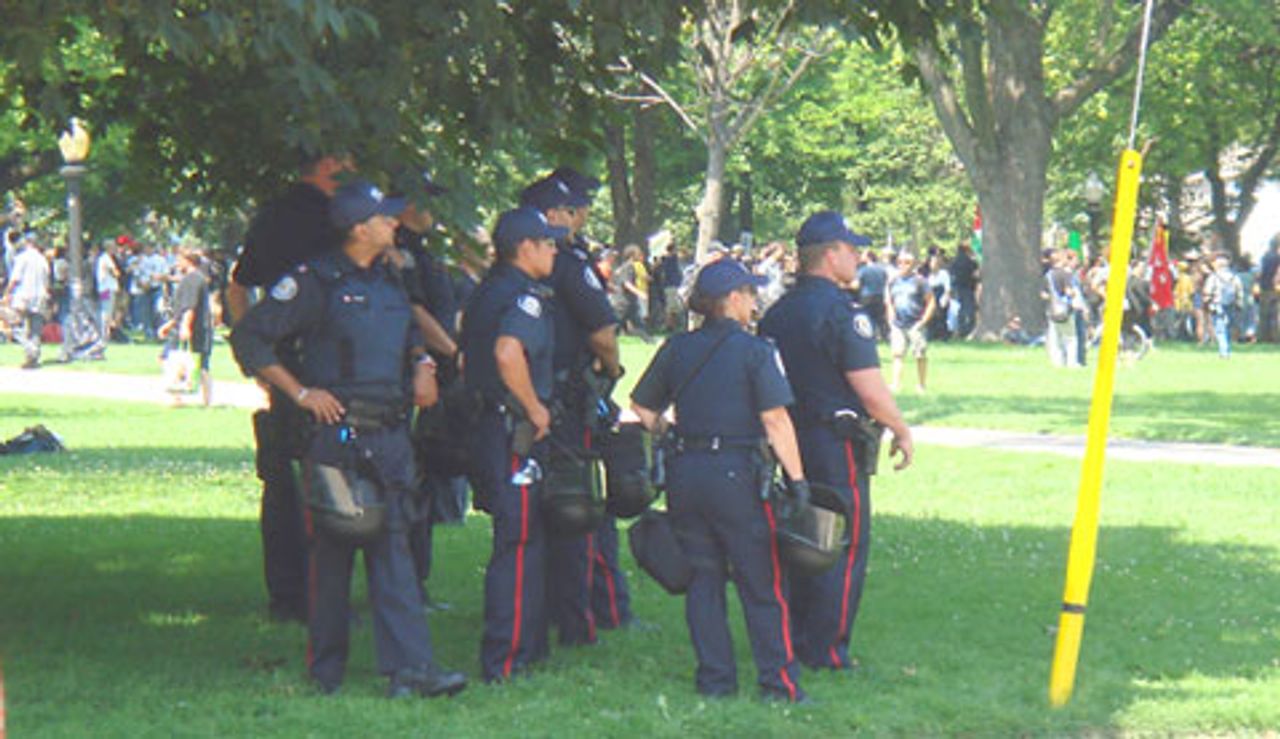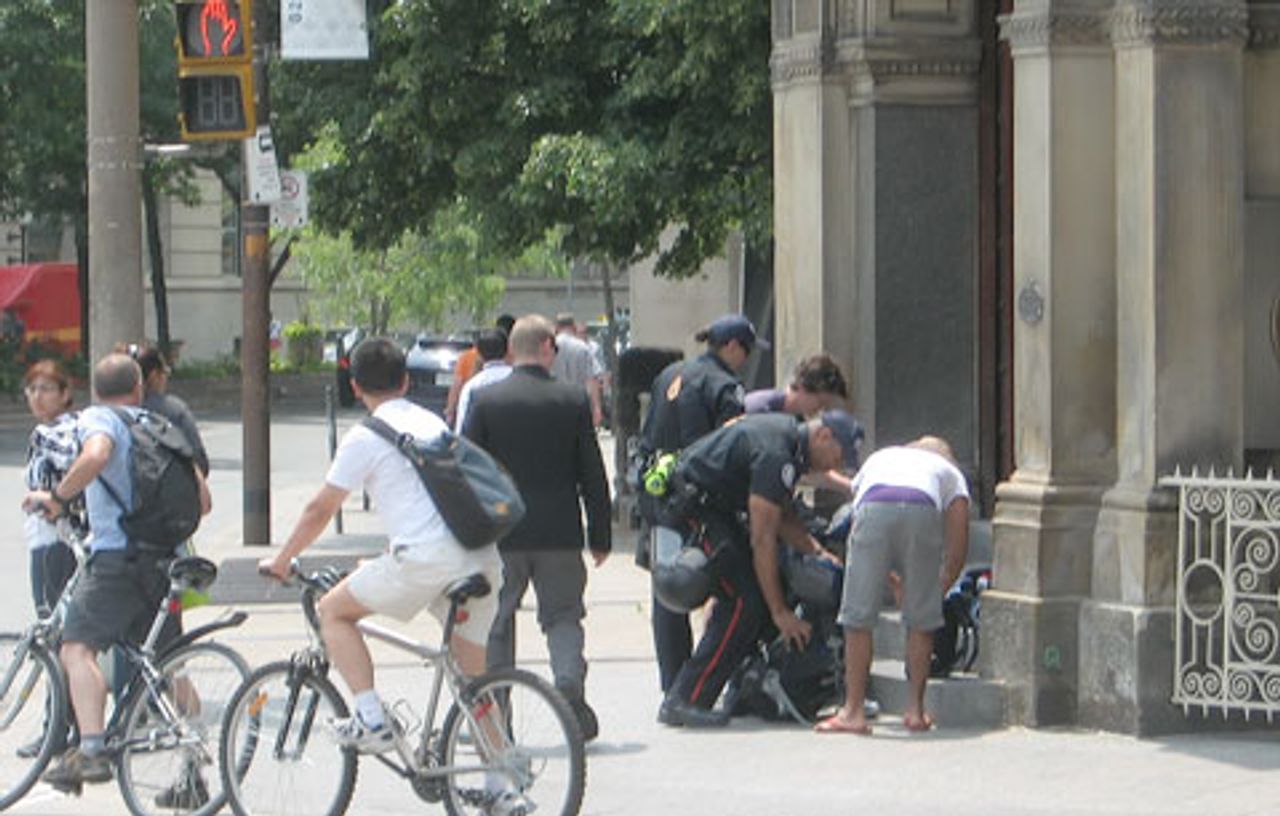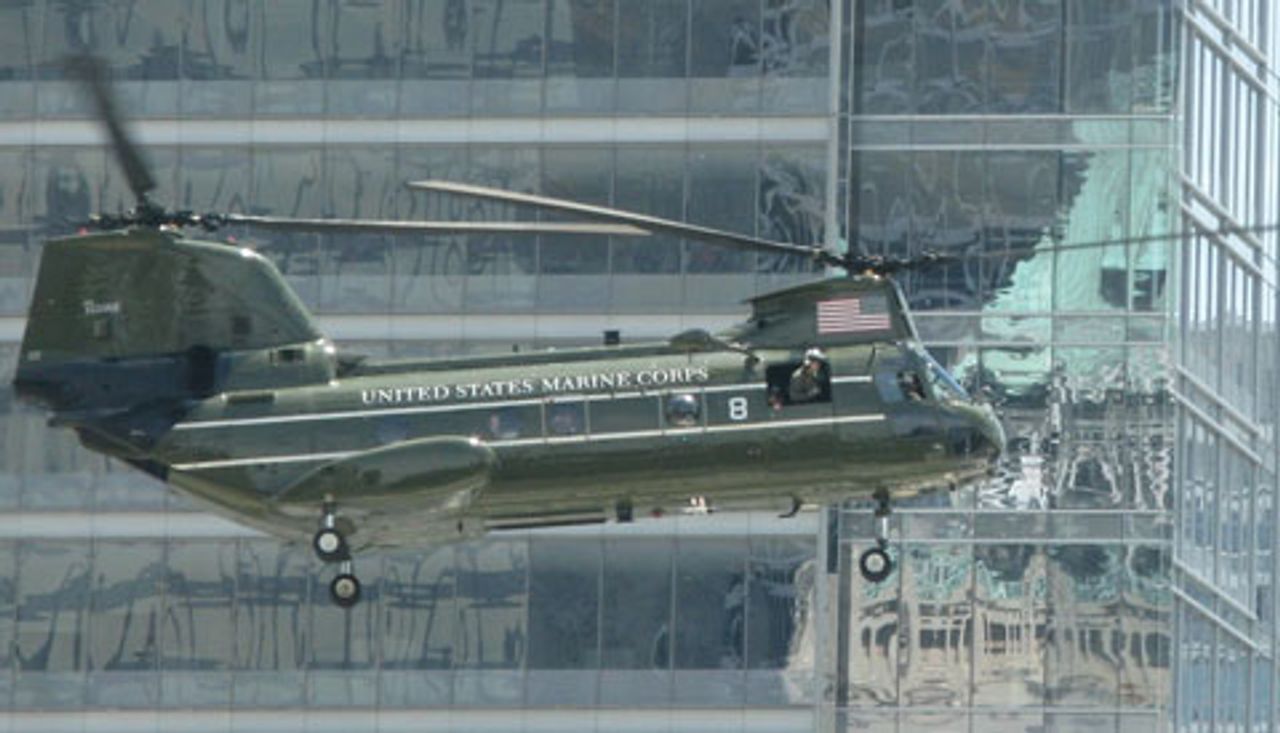 A section of the hundreds of police mobilized for an Ontario Coalition Against Poverty (OCAP) anti-G8/G20 protest held Friday afternoon at Allan Gardens, which is situated several miles from the summit site. The police almost out-numbered the 500 protesters.
A section of the hundreds of police mobilized for an Ontario Coalition Against Poverty (OCAP) anti-G8/G20 protest held Friday afternoon at Allan Gardens, which is situated several miles from the summit site. The police almost out-numbered the 500 protesters.Canada’s Conservative government and police-security establishment are using this weekend’s G20 summit in Toronto (and the smaller G8 summit in rural Huntsville) to acclimatize the population to police-state type measures and to refine their repressive techniques and operational capabilities for use in the event of widespread social unrest.
On the eve of the G20 summit meetings, downtown Toronto has all the hallmarks of a city under a state of siege. Six kilometres of fencing, topped with concertina wire and anchored in concrete encircle the “red zone”—the actual meeting area. Police checkpoints fan out another kilometre from the convention location. Snipers have been stationed on the city’s high rise rooftops. American Navy Seals surreptitiously patrol the harbour.
 Police search backpacks in downtown Toronto. A cop told the two pedestrians in this picture, “We need to check that you don’t have any weapons in your bags.”
Police search backpacks in downtown Toronto. A cop told the two pedestrians in this picture, “We need to check that you don’t have any weapons in your bags.”Citizens in the vicinity have been instructed to carry picture identification and expect curb-side interrogation by any of the thousands of police officers brought in from across the country. Canine units wait in the side-streets. Phalanxes of federal, provincial and municipal police stand at every corner buttressed by more mobile bicycle and horse patrols. Even truck drivers have been approached to act as “look-outs” for the police.
In addition, a thousand private security guards are deployed throughout the city’s adjacent financial and entertainment districts. Seventy-seven new closed circuit surveillance cameras monitor all movement on the streets. Water and sound cannon have been moved into place. Police helicopters hover constantly overhead. Security Service operatives sweep through the hotels and Canadian Armed Forces soldiers stand “on the ready” at “undisclosed locations”.
 A US marine helicopter hovers over Toronto’s financial district Friday morning.
A US marine helicopter hovers over Toronto’s financial district Friday morning.Over the past several weeks scores of anti-G20 activists have received “visits” from police at their homes and workplaces. Police have been instructed to make themselves visible at the organizational meetings of groups protesting the summit. Other “undesirables”—the ubiquitous homeless on downtown streets—have been removed.
Everything is being done to encourage the perception that any expressed anti-government sentiment is beyond the pale, and that hordes of “Black Bloc Anarchists” are planning to run riot through the streets of Toronto. A large, makeshift jail lies behind barbed wire on the grounds of a film production studio awaiting protestor “intake.” Hospitals have been placed on an emergency footing. Trees have been uprooted so as not to provide “weaponry” for the “extremists”.
In the press and in the communications issued to government, bank and entertainment workers by their managements, employees are advised “to hope for the best but expect the worst”. Instructions from human resources departments advise to “dress down” so as not to invite attacks from protestors. “Don’t talk to demonstrators. Just turn and walk the other way”, says one circular distributed to a government department. “But what if I agree with them?” rejoined one blogger.
Throughout the week, activists campaigning for gender equality, gay and native rights and against war and poverty have mounted small, peaceful and uneventful demonstrations and rallies geared towards “sending a message” to the assembled representatives of the global ruling class. On each occasion there have been more police in attendance than marchers. Yet this has not stopped the security and human resources departments of the major corporations and financial houses in Toronto’s main business district—who receive daily briefings from the police—from instructing operational units to switch over to their suburban backup sites, work-at-home or simply close down entirely for the entire week!
Earlier, summit security officials prevailed on the city’s professional baseball team, the Blue Jays, to relocate a three-game weekend home series against the Phillies to Philadelphia.
By Thursday and Friday, Toronto’s downtown core had been decidedly depopulated.
The combined price tag to mount the two day G20 summit in Toronto and the smaller gathering Friday of G8 leaders in the resort town of Huntsville north of the city has now reached $1.2 billion. The tally exceeds the $898 million spent for over two weeks of security at last February’s Vancouver Olympics, the $30 million spent to secure the London G20 and the $18 million outlay for last year’s event in Pittsburgh, Pennsylvania.
The aggressive assertion of state-police power in Canada’s largest city has been widely condemned by civil liberties and anti-poverty groups and by the unions. There is also much anecdotal evidence to suggest that many, if not most, Torontonians resent the effective takeover of their city centre by thousands of security personnel and the accompanying restrictions on their civil liberties, viewing this as a highly exaggerated and patently unjustified response to an amorphous “terrorist threat”.
Among the ruling elite, however, there is overwhelming support. Globe and Mail columnist Marcus Gee, who came to prominence as an early and enthusiastic proponent of the illegal 2003 US-British invasion of Iraq, penned a column this week that argued “the helicopters, the water cannons, the ugly fence, the countless cops” would be almost entirely “unnecessary if” anti-G20 protesters “simply agreed to renounce violence”. Although the groups protesting against the G8 and G20 have all but unanimously condemned violence, Gee claimed this to be “something they consistently refuse to do”.
Security forces have claimed the right to take over Toronto’s financial district under the federal Foreign Missions and International Organizations Act. Following the 2001 demonstrations against the Summit of the Americas in Quebec City, the Liberal government of Jean Chretien amended the act to stipulate that “the Royal Canadian Mounted Police may take appropriate measures, including controlling, limiting or prohibiting access to any area to the extent and in a manner that is reasonable in the circumstances”. The vague terminology and the absence of any reference to the rights of free movement and free speech that are reputedly guaranteed under Canada’ Charter of Rights and Freedoms have provided police organizations with the ability to impose martial-law-like restrictions at will.
But even this carte-blanche was deemed inadequate by Toronto Police Chief Bill Blair and the provincial Liberal government of Dalton McGuinty. At the “extraordinary request” of the police chief, the provincial cabinet on June 2 secretly passed a new regulation under the Ontario Public Works Protection Act that allows police to arrest anyone within five meters of the security zone who refuses to submit to a request for identification or a search of their person. The new law, in effect until June 28, was not publicized. Its public exposure occurred when it appeared without notice on a provincial e-laws database last week. Despite hundreds of briefings given to the citizens of Toronto over the past month, police consistently withheld this information. “It reminds me a little bit of the War Measures Act”, said Nathalie Des Rosiers of the Canadian Civil Liberties Association.
On Saturday, a “People First” protest organized by the Canadian Labour Congress (CLC) and the Ontario Federation of Labour (OFL) will mobilize trade unionists, civil rights activists, church groups and non-governmental organizations for a march through the streets of downtown Toronto. Sid Ryan, head of the OFL, and Ken Georgetti of the CLC have assured police that their march will be a peaceful, “kid friendly” affair (although several split-off groups of radicals plan to leave the march at its southernmost point in order to confront the police at the perimeter fence).
Protest organizers, including Ryan, have sent letters and repeatedly asked police and government representatives if they will undertake not to use agent-provocateurs during the demonstrations. Ominously, neither the Harper Conservative government nor the police have seen fit to provide a direct answer—the police content to simply issue a statement to the effect that they “do not discuss operational details”.
The concerns of Ryan and other protest leaders are legitimate. It would not be the first time such tactics were used to create the conditions for further curtailment of democratic rights. In 2007, at a North American leaders’ conference in Montebello, Quebec, police dressed as demonstrators were filmed carrying rocks and agitating amongst the crowd to join them in violent acts. (See: “Canada: Police agent-provocateurs unmasked at Montebello summit protests”). And in 2001 at the Genoa, Italy, G8 conference, police agents were discovered to have instigated violence during protests.
These facts, however, did not prevent the leader of the Toronto Police Association, Mark McCormick, from demanding Ryan’s resignation from the presidency of the OFL for “defaming the police”. The police have promised to confront demonstrators who may seek to take their protest directly to the perimeter fence. According to CLC President Ken Georgetti, “they’ve told us as soon as we hit Queen Street (fours blocks from the perimeter) there’s going to be a wall of cops with shields and batons to make sure we know where to turn”.
This author also recommends:
Canada to mount largest-ever security operation for G8/G20 summits
[29 May 2010]
Opposition parties abet cover up of Canada’s Afghan war crimes
[21 May 2010]
